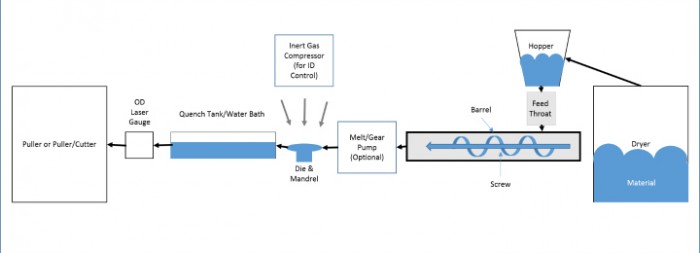Medical Extrusion — Finding The Right Sourcing Partner
By Biomerics
In the medical field, extrusion is rapidly becoming more and more popular. Unfortunately, with the advances in medical device technologies, products and extrusion requirements are also becoming increasingly complex and demanding. Device developers and OEMs are continually searching for sourcing partners who can efficiently and cost effectively deliver elaborate extrusions that meet the exact specifications of unique medical products. For this reason, we’ve leveraged the expertise, knowledge, and experience of our engineering team to explain how extrusion works, what it’s used for, what to look for in an extrusion sourcing partner, and the extrusion solutions Biomerics offers.
What is extrusion, and how does it work?
According to Dave Winn, a Process Engineer at Biomerics with over 15 years of extrusion experience, “Extrusion is used to create things we use every day. From candy licorice, to telephone cables, we use things that are extruded without even realizing it. Extrusion canbe used to create rigid, flexible, short, long, simple, or complex tubing of any shape.”
When asked about how extrusion within the medical field works, Craig McCaffrey, President of the Biomerics Salt Lake City branch, responded, “Extrusion is very similar to injection molding, in theory. You’re using a hopper full of resin, a screw, a barrel, and heat to create something. The difference between the two [injection molding and extrusion] is that with extrusion you’re forcing material through a die and mandrel, not into a mold cavity, and there is no cycle. You’re continuously running the material through the extruder to create product.”
A thermoplastic medical extrusion process would follow a flow similar to the diagram below. Note that black lines represent the flow of material and gray lines represent the flow of inert gas:

The process of extrusion begins when the material is dried and enters the hopper, where it is gravity fed from the hopper into the feed throat. From the feed throat, the material enters the barrel where the screw creates enough pressure and heat for the material to melt.Once the material melts and exits the barrel, it enters the melt/gear pump (if installed) where it is metered for volume consistency and then forced through the die and mandrel. The die and mandrel create the profile of the extrusion (i.e. they control the inner diameter ofthe extrusion) and are supplied with inert gas to keep the inner lumens of the extrusion consistent. After the extrusion flows through the die and mandrel, it enters the water bath where it is cooled. Once cooled, the extrusion passes through the OD laser gauge, where it is measured to ensure that the process is operating within the set window. Finally, the extrusion is pulled from the die by the puller and, depending on device requirements, is cut or wound.
What is extrusion used for in the medical device field?
In the medical device field, extrusion is used to create catheters, IV and drainage tubing, needle and syringe caps, and any other kind of component or device that requires a profiled tube or shaft. “Anything in the operating room that looks like a cable, tube, or chord is extruded,” explained Winn. “In fact, a lot of the tubing and catheters you see actually have multiple lumens so that the device can serve more than one purpose. Physicians are continually trying to do more with less, and device companies are starting to catch on by extruding complex multi-lumen configurations. The idea is that it’s safer to have one multi-purpose device in your body than two or three single-purpose devices,” added McCaffrey.
What should you look for in an extrusion partner?
When asked this question, McCaffrey answered, “The number one thing any company should consider before selecting an extrusion partner is their capabilities. Make sure the extrusion partner chosen has the expertise and equipment to manufacture the extrusion specified. Otherwise, no value, products, or improvements will come from the partnership.
“Another thing I would suggest is that a company look into the quality and feedback controls that the extrusion partner’s processes have. Online quality control mechanisms such as laser gauges and heat centering systems allow the extruder to adjust the process in real time. Offline quality control systems, such as non-contact measurement and other advanced inspection techniques further enable extruders to improve their processes so that they are producing high-quality parts. If an extrusion partner doesn’t have these things in place, the production quality of parts can vary significantly.”
Winn added, “I suggest that everyone look to make sure their extrusion partner has in-house tooling capabilities. Very rarely does the tooling create a conforming part on the first go-round. It usually takes around four tooling iterations to get it correct. If an extruder doesn’t have tooling capabilities in house, these rounds of iterations can end up costing a company a lot of time and money.”
How can Biomerics help with my next extrusion project?
At Biomerics, we produce thermoplastic extrusions that meet the precise specifications of demanding clinical applications within the cardiovascular, structural heart, CRM/electrophysiology, neurovascular, vascular access, and pain management markets. Through close collaboration with our customers, we can manufacture complex multi-lumen extrusions, co-extrusions, and bump tubing used in a wide range of advanced medical procedures. Our in-house tooling and advanced quality and process control systems enable us to cost effectively handle challenging levels of product intricacy and material compounds.
For more information, visit www.biomerics.com.
